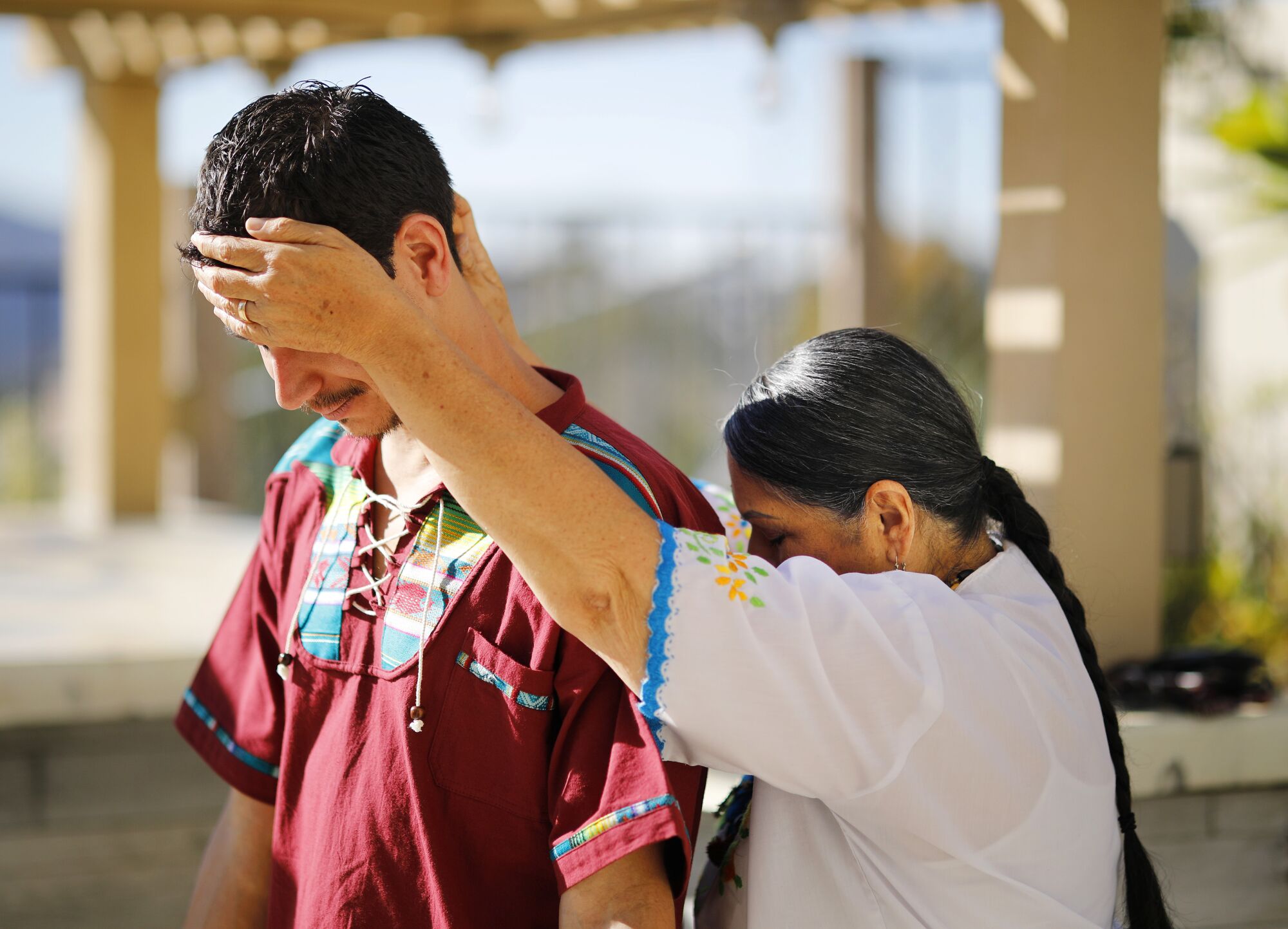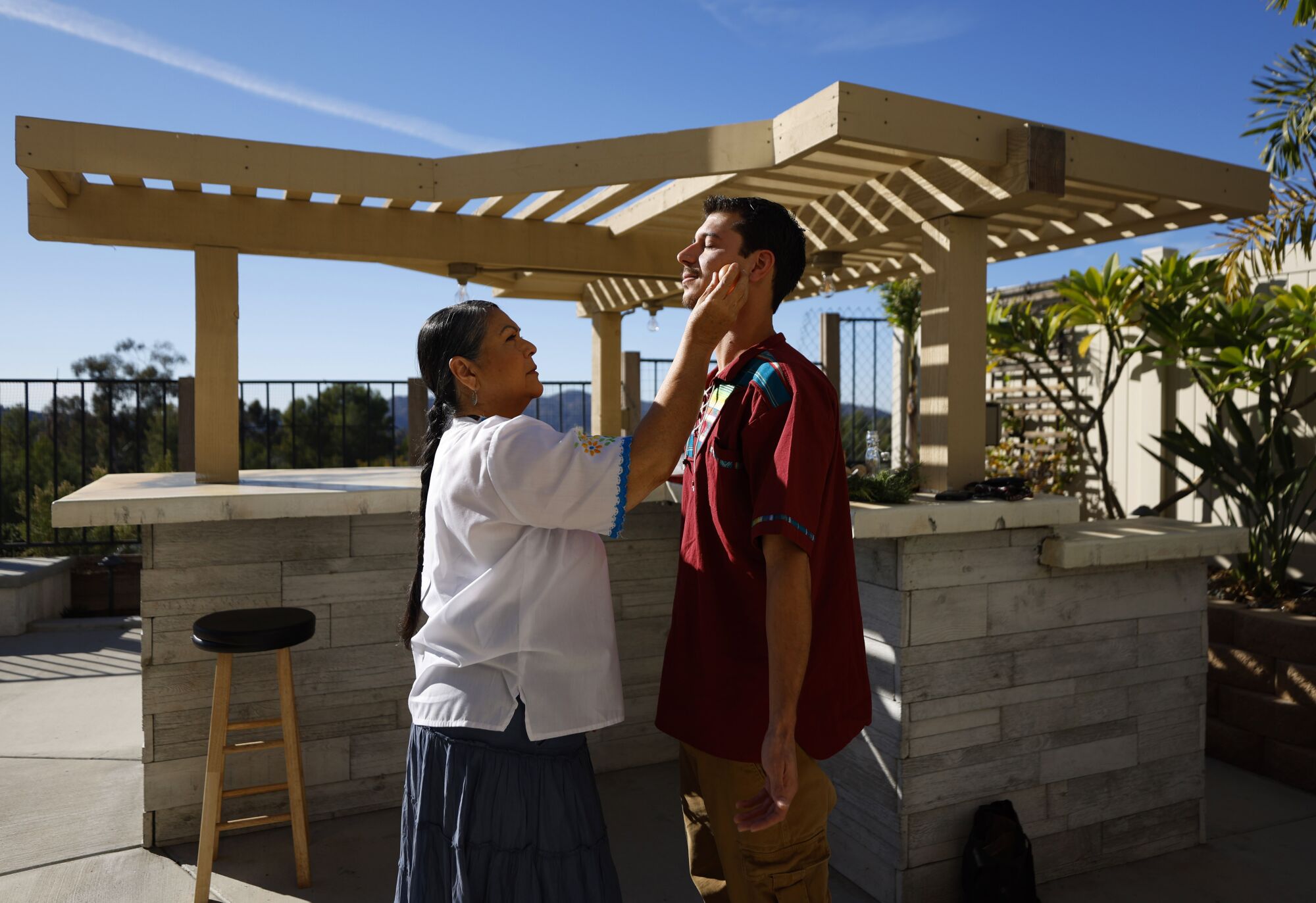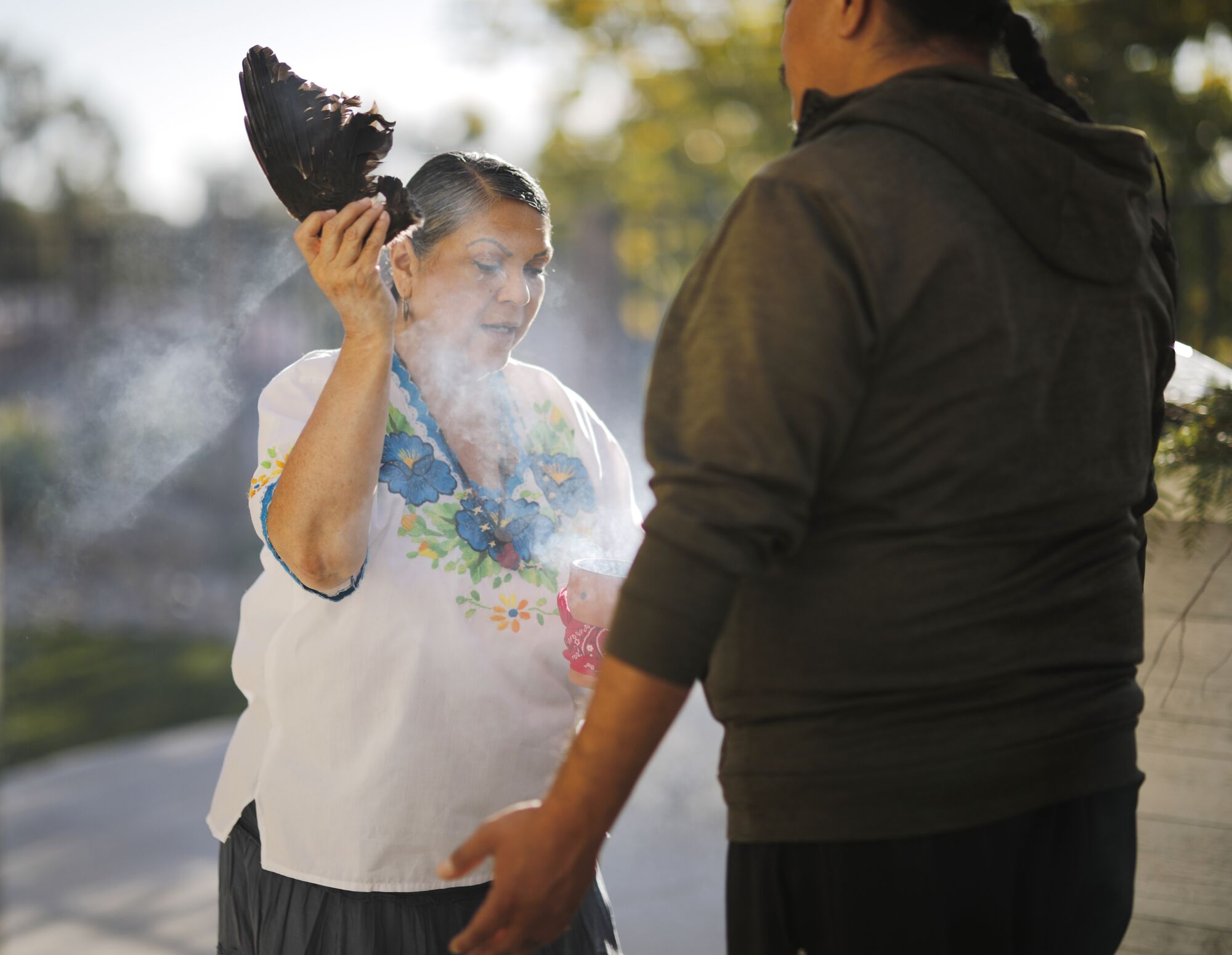Latinos distrust Western mental health. Curanderos help.

Grace Sesma works methodically to set up her home office, lighting candles and cutting thorns from seven stemmed red roses for the day’s first session as her client chatters nearby.
The man, 47, is talking fast — about the nice view of the area from Sesma’s backyard, his connection to the San Diego area, and how he got the supplies at the last minute that Sesma told him they would need: roses, an egg and tobacco.
A survivor of childhood sexual abuse, he has used binge drinking as a coping mechanism. He’s been seeing a therapist and was recently diagnosed with post-traumatic stress disorder. Therapy has helped him identify his behavior and triggering environments, but he still hasn’t come to terms with the sexual abuse he suffered, he said; he wants to be at peace with himself.
That’s why he has traveled to Alpine, a small mountain community northeast of San Diego, to see Sesma. A therapist can teach him coping skills, but Sesma is here to help him repair his spirit.
Sesma, 65, is a Mexican and Yaqui curandera, or traditional healer. Clients come to her home office, in Alpine or Colorado, for a range of needs, including PTSD, nervios (panic attacks), susto (trauma), depression and spiritual counseling.
This wasn’t her first line of work. Sesma spent several years as an administrator of a partial-hospitalization psychiatric program and founded a cultural consulting firm, but she felt called by her ancestors to follow a spiritual healing path and serve her community.
“The philosophy behind curanderismo is that diseases are not just caused by physical factors, but also social, emotional, environmental and spiritual ones,” Sesma said.
Sesma helps clients with PTSD, panic attacks, depression and other issues from her home in Alpine, northeast of San Diego.
(K.C. Alfred / San Diego Union-Tribune)
Sesma is part of a world of traditional healers who are generally not considered by Western medicine to be a part of the mental health system, but for their clients, especially among a subset of Latinos, Chicanos and Indigenous peoples from Latin America, these spiritual healers offer a type of support they may trust more than therapists.
Data continues to show that Latinos do not seek out therapy or other mental health support at the same rates as other racial or ethnic groups. An increasing number of Black, Asian and white Americans are seeking out mental health treatment while the rate of Latinos remains near stagnant, according to a recent analysis by the Centers for Disease Control and Prevention. This could be in part because of relatively low numbers of Latino mental health providers, a fact that could affect who seeks treatment as some patients want a provider who understands their cultural background. Stigma surrounding mental health conversations and services could be another factor. Little data, if any, is collected on those who seek support from spiritual healers.
Both healers and researchers say Latinos and other Southern Californians, who aren’t necessarily connected to the culture, often turn to curanderismo when they’ve felt Western medicine didn’t meet their needs. It is difficult to definitively measure the medical benefits of spiritual healing, but these same experts point out that an integrative approach with doctors and healers working together in clinics arguably produces benefits beyond those easily documented in an X-ray or CT scan.
“In other countries such as China and India, traditional medicine has been merged with modern medicine and people have options of selecting one or both types of medicine,” said Eliseo Torres, a faculty member of the College of Education at the University of New Mexico. Recently, “a group of staff and a physician visited [a university health clinic in Mexico] where traditional medicine has been merged with modern medicine. We returned to the U.S with the idea of doing the same.”
Curanderismo is the holistic approach to healing the mind, body and spirit. A person who can heal others by looking at the whole of the person (mind, body and spirit) is called a curandera.
There are other types of healers under the curanderismo umbrella, and each has their own approach based on their teachings. For example, Sesma’s teachings are rooted in Mexican and Indigenous culture.
In the U.S., these healers aren’t typically found working alongside doctors and nurses in primary care practices, but that’s changing in small pockets of the U.S. and other parts of the world. It’s similar to the recent movement in California, Arizona and other states where Indigenous leaders are pushing for Medicaid reimbursement to cover traditional healing services that they see as beneficial to tribal members’ mental health.
Sesma is currently working with the Academy for Integrative Health and Medicine, a global community of medical professionals working toward a holistic and integrative health approach to care, where she’s sharing her knowledge of traditional healing. Their collaboration will result in training for the organization’s students and members on Indigenous healing practices.
For almost a decade, a program at a university in Mexico has trained healers to work in clinics and hospitals. Their graduates, once dubbed “brujas” (“witches”), “witch doctors” or other slurs by their medical counterparts, are finding acceptance.
“Nos vamos a revolucionar el mundo de la atención médical de Mexico,” said Rafael Colin, director of the five-year bachelor’s degree program at Universidad Intercultural del Estado de México. “We’re going to revolutionize the world of healthcare in Mexico.”

Roberto Camacho said he was in the process of making several life changes when he sought out Grace Sesma’s help.
(K.C. Alfred / San Diego Union-Tribune)

Sesma “has helped me look at my life with more clarity and from a perspective of abundance,” Camacho said.
(K.C. Alfred / San Diego Union-Tribune)
A blending of healing practices
In a series of dreams that started when she was a teenager, Sesma said she was visited by the spirits of her Indigenous grandmothers, who urged her to “return to the ways of the ancestors” and practice spiritual healing.
It’s not uncommon for curanderos to say they have been called to this work through dreams or visions. An elder can also recognize whether a person has this healing gift and help cultivate it through an apprenticeship.
Before Sesma listened to the calling, she worked and raised a family as a single mother. It wasn’t until her 40s that she was ready to begin her apprenticeship with a curandero in Tecate, Baja California, and understand how to heal a whole person.
Curanderismo comes from the Spanish word curar, to heal.
Researchers have found that curanderismo dates back to Aztecan, Mayan and Incan tribes and their religious beliefs of harmony with nature, spirit and self.
When Spain colonized Mexico in 1519, the healing practice evolved to include European practices of healing, Torres said.
When the Spanish arrived in Mexico, Torres said, they brought their own culture, belief system and plant knowledge, introducing it to the native healers. The healers then incorporated the Spanish healing methodologies in their practice.
Torres, author of “Curandero: A Life in Mexican Folk Healing,” leads a summer course at the University of New Mexico in Albuquerque about the history of curanderismo. The course explores an integrative approach to medicine — traditional healing complementing modern medicine.
He brings in guest speakers who are healing practitioners from the Southwest and Mexico. The course explores how traditional healing methods have shaped how we treat people in the past, today and what it could be in the future. His students range from people who have some spiritual healing knowledge, people who want to reclaim their culture through these teachings and others who want to learn how to care for themselves.
“We try to train people to take care of their own body, to become their own healers, and [in some cases] to learn what their grandfathers and grandmothers did years ago,” said Torres, whose parents taught him about Mexican folk healing.
In Mexico, students at the Universidad Intercultural del Estado de México in San Felipe del Progreso, about 100 miles northwest of Mexico City, are also learning an integrative approach to medicine that they can actively use in the medical field.
The university offers a five-year bachelor’s degree program called the Licenciatura en Salud Intercultural that focuses on four healing methods: Mexican traditional medicine, Chinese acupuncture, psychosomatics (healing the mind and body), and conventional medicine.
“Research shows that there are a lot of degenerative diseases that have an emotional aspect, so these professionals will be able to make a clinical diagnosis based on [conventional allopathic] medicine and then it’s up to [the doctor] to choose what kind of treatment they are going to use,” Rafael Colin, director of the program, said.

Spiritual healers such as Sesma offer a type of support that some clients trust more than therapists.
(K.C. Alfred / San Diego Union-Tribune)
The Mexican traditional healing portion of the program includes classes with parteras (midwives), yerberas (herbalists), sobadoras (traditional bodyworker) and temazcaleras (who work in sweat lodges).
Treycy Velazquez, a licensed practitioner of cross-cultural health and a graduate of the first Licenciatura en Salud Intercultural cohort, now heads the traditional medicine portion of the program.
She said they welcome adult students of all ages with the understanding that they aren’t “blank pages.” Many of the students are healers in their communities, are related to a healer, or have some understanding of the practice.
Velazquez is a descendant of traditional healers. She remembers her grandmother and mother using herbs and plants to heal people and enrolled in the program about eight years ago.
Part of the class curriculum is to connect with a community and learn from their healer, which isn’t easy. She said it’s common for the healer to be reluctant to share their skills and work because they’re unsure of the students’ intentions.
“It’s [hard] work because we don’t want to just extract their knowledge,” Velazquez said. “This [exercise] is about acknowledging these individuals and protecting their knowledge.”
Students also work with patients in the university’s clinic and conduct research. Colin said the goal of the program is to demonstrate the effectiveness of this ancient knowledge — and preserve it by teaching it.
It’s also working to “professionalize” this knowledge by understanding the science in it and backing it up with research, Colin said. For example, the program and the National Autonomous University of Mexico will be collaborating on studying “how acupuncture and traditional herbs have synergy [to treat] some diseases” on patients who visit the program’s clinic.
Students who complete the program are then able to establish a practice and have a license to practice the four healing methods, including Mexican traditional healing, in a hospital or clinic.
The first cohort of graduates were met with some stigma, labeled as “brujos”, Colin said.
However, the graduates interned with Mexico’s secretary of health, as all health professionals are required to do in the state, and quickly proved themselves to their medical counterparts by working side-by-side to treat patients.
Recent program graduate Vanessa Carrillo Sarmiento wasn’t met with name-calling, but at the Hospital Mazahua, doctors at first didn’t acknowledge her as a colleague.
The hospital is in the small town of Santa Ana Nichi in Mexico; its population of nearly 3,000 is mostly Mazahua Native people.
Since graduating in 2019, she’s provided holistic therapies and physical therapy for patients with facial paralysis, joint or muscle pain, insomnia and anxiety.
But the first six months were challenging for Sarmiento because she didn’t have any patients.
To fix that, she made it a point to introduce herself to the medical doctors on staff and talk to them about how she cares for patients through traditional massage work or taking more time to explain post-treatment care.
Some doctors took a chance and sent their patients to her.
They soon learned her value, Sarmiento said, after seeing their patients benefit from her care and now they see her as part of the medical treatment team.
“I believe that the basis for the acceptance we have had with the hospital doctors was that they realized that we are a complement to the work they do and vice versa, just as we need them to achieve significant improvement in the patient,” she said.
Sarmiento has developed trust with her patients, her community, and has many who return to the hospital regularly for her services.
This relationship between a healthcare provider and patient is one that she wishes her grandparents could have experienced.
She remembers that her grandparents loathed doctor visits because they didn’t feel heard or were scolded.
“For me, I would have liked that my grandparents were treated the way that I treat my patients. … The closeness that you have with people is the most beautiful thing that the profession gives you,” Sarmiento said.
Complementary healing
Back in Alpine, Sesma sees five clients in-person and two via Zoom over the next two days. One of her clients is Roberto Camacho, a Chicano journalist and activist in San Diego, who is coming for his second session.
He’s seeking spiritual counseling to “clear his mind and body of self-doubt and negative thoughts” because he’s making a lot of life-changing decisions — applying for jobs and looking to move out of state.
“Reflecting back on my most recent session, I believe [Sesma] has helped me look at my life with more clarity and from a perspective of abundance,” Camacho said.
All of Sesma’s clients, including Camacho, talk about how much they value the time that Sesma gives them and her services. Sesma and other healers wish the medical field could value traditional healing methods too.
“It is more likely, that I or other curanderas, would refer a client to a doctor or an ophthalmologist or gynecologist, than they are to refer [clients] to me,” she said.
Sesma feels that doctors don’t acknowledge traditional healing as a mainstream method of healing because they haven’t taken the time to learn about it or resist learning about it because it conflicts with their religious beliefs.
She doesn’t have the skills of a physician, for example, but a physician doesn’t have her skill-set. So why can’t they work together “for the benefit of the patient’s whole well-being?” she asked.
“Let’s have some humility to understand that [science-based] allopathic medicine does not necessarily address every issue that the patient may present with,” she said. “There’s a spiritual aspect to all of us as human beings that not everyone is equipped to take care of, to handle or to address.”

Sesma sees her work as benefiting “the patient’s whole well-being.”
(K.C. Alfred / San Diego Union-Tribune)




